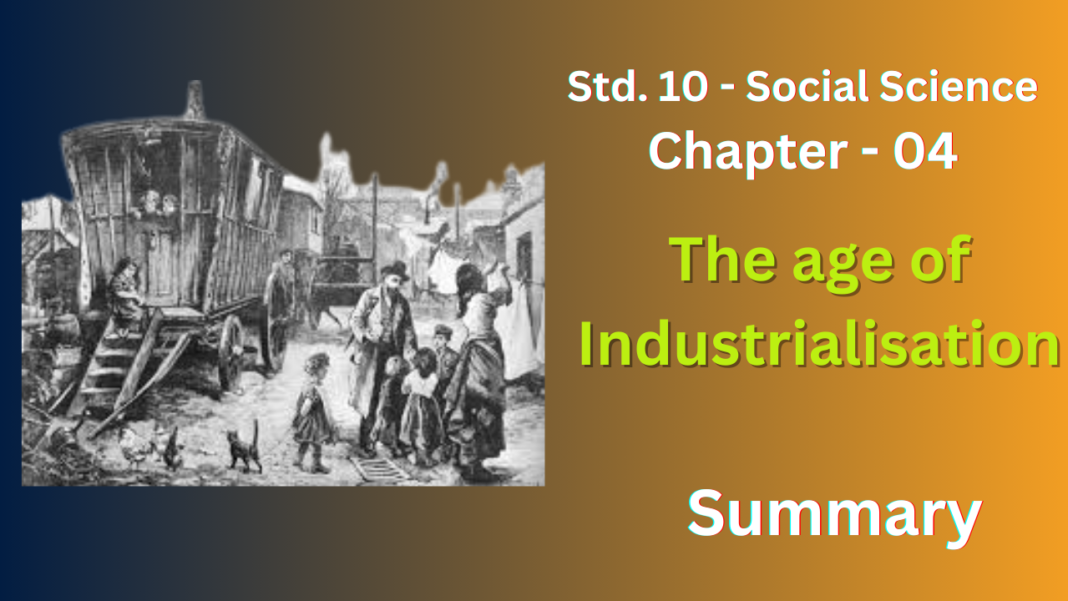NCERT Solutions for class 10 History Chapter 4
The chapter The age of Industrialisation explores the rise of factories and the dramatic changes it brought to society. Here are the key points:
Before Factories:
- Small-scale production using manual labor existed before factories. This is sometimes called “proto-industrialization.”
- Merchants often worked with rural artisans, supplying them with raw materials and buying finished products for international trade.
The Rise of Factories:
- The Industrial Revolution, starting in Britain in the 18th century, saw a shift from manual labor to machine-based production in factories.
- Key inventions like the spinning jenny and the power loom revolutionized textile production.
- Steam engines provided a reliable source of power, further accelerating industrial growth.
Impacts of Industrialisation:
- Urbanization: People migrated to cities in search of factory jobs, leading to rapid growth of urban areas.
- Social Change: The rise of factory owners (bourgeoisie) and industrial workers (proletariat) created a new social order.
- Working Conditions: Factory work was often harsh, with long hours, low wages, and unsafe conditions. This led to calls for reform and the rise of labor unions.
- New Inventions and Industries: Industrialization spurred innovation in various fields, leading to new inventions and the growth of new industries like steel, chemicals, and transportation.
The Age of Industrialisation in India:
- While the Industrial Revolution began in Britain, its effects were felt globally.
- In India, the first cotton mills were set up in the mid-19th century, mainly under British control.
- This led to the decline of traditional Indian handicraft industries.
- The exploitation of Indian raw materials and cheap labor benefited British industries.
NCERT Solutions for class 10 History Chapter 4 The age of Industrialisation
Exercise
Explain the following :
(a) Woman workers in Britain attacked the Spinning Jenny. [CBSE Sept. 2011]
(b) In the seventeenth century, merchants from towns In Europe began employing peasants and artisans within the villages.
(c) The port of Surat declined by the end of the eighteenth century.
(d) The East India Company appointed Gomasthas to supervise the weavers in India.
Ans :
(a) Women Workers Attacked the Spinning Jenny:
During the Industrial Revolution in Britain, women workers sometimes attacked machines like the spinning jenny. Here’s why:
- Fear of Job Loss: These machines could spin yarn faster and more efficiently than hand-operated spinning wheels. Women feared being replaced by machines, leading to unemployment and loss of income.
- Wages and Working Conditions: The introduction of machinery often led to lower wages for women workers and potentially harsher working conditions in factories.
(b) European Merchants Employed Peasants and Artisans:
In the 17th century, a system called the putting-out system emerged in Europe. Here’s how it worked:
- Merchants Provided Materials: Merchants from towns would provide raw materials like wool or flax to peasants and artisans living in villages.
- Production in Homes: These rural artisans would then use their skills to produce goods like cloth in their own homes, often with the help of their families.
- Merchants Collected Finished Goods: Once finished, the merchants would collect the finished products and sell them in markets, often at a significant profit.
This system allowed merchants to access a wider workforce and reduce production costs compared to urban workshops.
(c) Decline of the Port of Surat:
The port of Surat, once a major trading hub in India, declined by the end of the 18th century due to several factors:
- Rise of Bombay: The rise of Bombay (now Mumbai) as a major port, with better harbor facilities and increasing British influence, diverted trade away from Surat.
- Political Instability: The decline of the Mughal empire and increasing political instability in the region disrupted trade routes and made Surat a less attractive option for merchants.
- Shifting Trade Patterns: Changes in global trade patterns, with new routes and ports emerging, also contributed to Surat’s decline.
(d) East India Company Appointed Gomasthas:
The East India Company, a British trading company that eventually ruled much of India, appointed Gomasthas for several reasons:
- Supervision of Weavers: Gomasthas were agents of the Company who supervised Indian weavers who produced textiles like cotton cloth. They ensured quality, quantity, and timely delivery of the textiles ordered by the Company.
- Control of Production: The Company aimed to control the production process to meet their specific needs and specifications. Gomasthas helped exert this control over Indian weavers.
- Advance Payments and Debt Control: The Company often advanced money to weavers to purchase raw materials. Gomasthas ensured that weavers used these advances for the intended purpose and collected the finished goods or recovered the debts.
2. Write True or False against each statement:
(a) At the end of the 19th century, 80 per cent of the total workforce in Europe was employed in the technologically advanced industrial sector.
(b) The international market for textiles was dominated by India till the eighteenth century.
(c) The American Civil War resulted in the reduction of cotton exports from India.
(d) The introduction of the fly shuttle enabled the handloom workers to improve their productivity.
Ans :
(a) False – By the end of the 19th century, the industrial sector was a significant employer in Europe, but 80% is likely an overestimation. Many people would still have been employed in agriculture and other sectors.
(b) True – India was a major exporter of textiles for centuries, but this dominance started to decline with the rise of the Industrial Revolution in Europe.
(c) False – The American Civil War disrupted cotton supplies from the southern United States, which actually led to increased demand for Indian cotton.
(d) True – The fly shuttle was a significant invention that increased the efficiency of weaving on handlooms by allowing for a faster back-and-forth motion of the shuttle.
3. Explain what is meant by proto industrialisation.
Ans :
Rural folks made stuff at home, not factories.
Merchants gave them materials, bought finished goods (clothes, for example).
More for markets, not just local use.
Set the stage for bigger, badder factories later.
NCERT Solutions for class 10 History Chapter 4 The age of Industrialisation
Discuss
1. Why did some industrialists in the nineteenth century Europe prefer hand labour over machines?
Ans : There were several reasons why some industrialists in 19th century Europe preferred hand labor over machines:
- Cost: Early machines were expensive to purchase, maintain, and power (often requiring steam engines). Hand labor, in comparison, was a readily available and cheaper option.
- Skill: Skilled craftspeople could produce high-quality goods that machines, at the time, couldn’t replicate. This was particularly important for luxury goods or items requiring intricate details.
- Adaptability: Hand labor offered greater flexibility in production. Workers could easily adapt to changes in designs or production needs, whereas machines were less adaptable and required significant adjustments.
- Limited Production Needs: For some industries, particularly those with smaller production volumes, the investment in machines might not have been justified. Hand labor could meet their needs efficiently.
- Labor Surplus: In some parts of Europe, there was a readily available pool of cheap labor, making hand labor a more economical choice compared to the initial investment in machines.
2. How did the East India Company procure regular supplies of cotton and silk textiles from the Indian weavers ?
Ans : The East India Company employed a series of methods to secure a steady supply of cotton and silk textiles from Indian weavers. These methods often involved control and exploitation of the weavers:
- Gomasthas: The company appointed agents called Gomasthas to supervise weavers. These agents ensured quality, quantity, and timely delivery of textiles ordered by the company.
- Advance Payments: The company often provided weavers with advances on their wages to purchase raw materials. This created a debt situation, tying the weavers to the company and limiting their ability to work for other buyers.
- Restricted Movement: Weavers who received advances were often restricted from selling their finished products to anyone else, ensuring the company received the textiles they had paid for.
- Price Control: The company dictated the price at which weavers would be paid for their work. This kept production costs low for the company but often resulted in unfair wages for the weavers.
- Coercive Measures: There are accounts of threats and violence used to ensure compliance from weavers, creating a system of control rather than fair trade.
3. Imagine that you have been asked to write an article for an encylopedia on Britain and the history of cotton. Write your piece using information from the entire chapter.
Ans : Britain and Cotton: A Woven History
Britain’s relationship with cotton is a complex and intertwined story, spanning centuries and shaping both the nation’s industrial identity and its global influence.
Early Encounters: Cotton first arrived in Britain in the 16th century, a luxurious import often blended with linen. As demand grew in the 18th century, Britain began relying heavily on imports of raw cotton, particularly from India, a leading producer of high-quality textiles.
The Industrial Revolution and the Rise of “Cottonopolis”: Britain’s own cotton industry boomed during the Industrial Revolution. Inventions like the spinning jenny and power loom transformed production, making cotton cloth cheaper and more readily available. Cities like Manchester, nicknamed “Cottonopolis,” became centers of bustling textile mills, churning out vast quantities of cotton fabric.
Fueling an Empire: The cheap and versatile cotton fabric became a cornerstone of British trade. It was exported around the globe, fueling the growth of the British Empire. Colonies became not only sources of raw materials but also captive markets for British-made textiles.
The Human Cost: Behind the success story lies a darker side. The demand for cotton fueled the exploitation of labor in colonies like India. The East India Company used a system of advances, restricted movement, and price control to secure supplies from Indian weavers, often at unfair wages and under harsh conditions.
A Changing Landscape: By the late 19th century, Britain faced competition from other industrialized nations like the United States and Japan. The reliance on a single industry also proved vulnerable to external factors like the American Civil War, which disrupted cotton supplies.
Legacy: Britain’s dominance in the cotton industry eventually waned, but its impact remains profound. Cotton textiles revolutionized fashion, making comfortable and affordable clothing accessible to the masses. The industry also played a significant role in shaping Britain’s economic and social landscape, leaving behind a legacy of innovation, exploitation, and ultimately, industrial transformation.
4. Why did the industrial production in India increase during the First World War ?
Ans : The First World War (1914-1918) witnessed a surge in industrial production in India for several reasons:
1. Substitute for British Goods: British industries were heavily focused on supplying war needs for their own troops. This led to a decline in exports of British manufactured goods, particularly textiles, to India. Indian mills were able to fill the gap in the domestic market, producing items like clothes for the growing demand.
2. Meeting War Demands: The British government also directly called upon Indian factories to produce essential war supplies. This included items like:
- Jute bags: High demand for jute bags for transporting supplies and sandbags on the battlefields.
- Cloth for uniforms: Indian mills produced large quantities of fabric for military uniforms.
- Leather goods: Boots, saddles, and other leather items were needed for the war effort, and Indian production played a role.
- Tents and other supplies: Indian factories contributed to the production of tents and other military necessities.
3. Increased Employment and Longer Hours: As production ramped up to meet wartime demands, factories in India employed more workers and often operated for longer hours. This increased overall industrial output.
4. Limited Competition: With the war disrupting global trade and European competitors preoccupied, Indian industries faced less competition in the international market. This created new opportunities for Indian exports.
However, it’s important to note that this wartime boom had limitations:
- Unequal Benefits: Large Indian industrialists benefited significantly, while the working class often faced harsh working conditions and low wages.
- Limited Technological Advancements: The focus was on fulfilling immediate war needs, not necessarily on long-term technological advancements in Indian industries.
- Post-War Challenges: After the war, the return of British goods and a decline in wartime demand posed challenges for Indian industries.
NCERT Solutions for class 10 History Chapter 4 The age of Industrialisation
FAQs
What is the main focus of NCERT Solutions for Class 10 History Chapter 4: The Age of Industrialisation?
The main focus of NCERT Solutions for Class 10 History Chapter 4, “The Age of Industrialisation,” is to explore the impact of industrialization on society, economy, and culture during the 18th and 19th centuries.
How did industrialization begin in Europe according to Class 10 History Chapter 4 The age of Industrialisation?
Industrialization began in Europe with the advent of new technologies and the establishment of factories, primarily in Britain, during the late 18th century.
What were some of the significant inventions during the age of Industrialisation discussed in NCERT Solutions for Class 10 History Chapter 4?
Significant inventions include the spinning jenny, the steam engine, and the power loom, which revolutionized textile production and other industries.
How did industrialization affect the lives of workers as explained in Class 10 History Chapter 4 The age of Industrialisation?
Industrialization led to the rise of factory work, which often involved long hours, low wages, and poor working conditions.
What was the impact of industrialization on the economy according to NCERT Solutions for Class 10 History Chapter 4 The age of Industrialisation?
Industrialization significantly boosted economic growth, leading to increased production, trade, and the rise of new industries and markets.
How did industrialization impact the environment according to Class 10 History Chapter 4 The age of Industrialisation?
The rapid industrial growth led to environmental degradation, including deforestation, air and water pollution, and the depletion of natural resources.
What role did women and children play in the industrial workforce as described in NCERT Solutions for Class 10 History Chapter 4 The age of Industrialisation?
Women and children were employed in factories due to their ability to be paid lower wages. They often worked in harsh conditions, contributing significantly to the labor force but facing exploitation.
`









